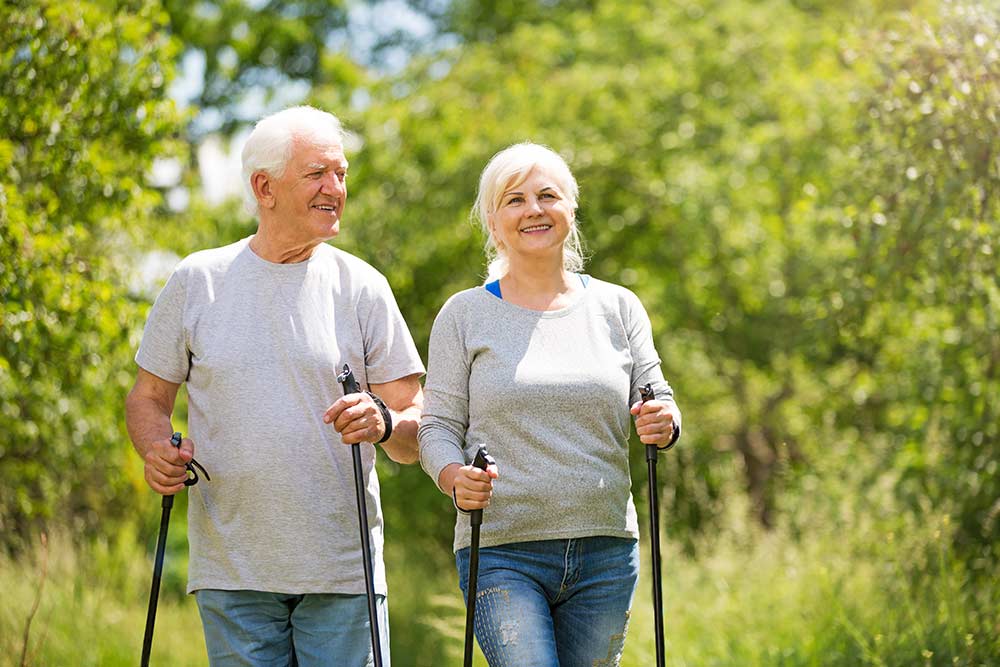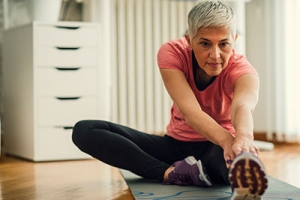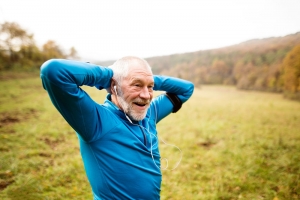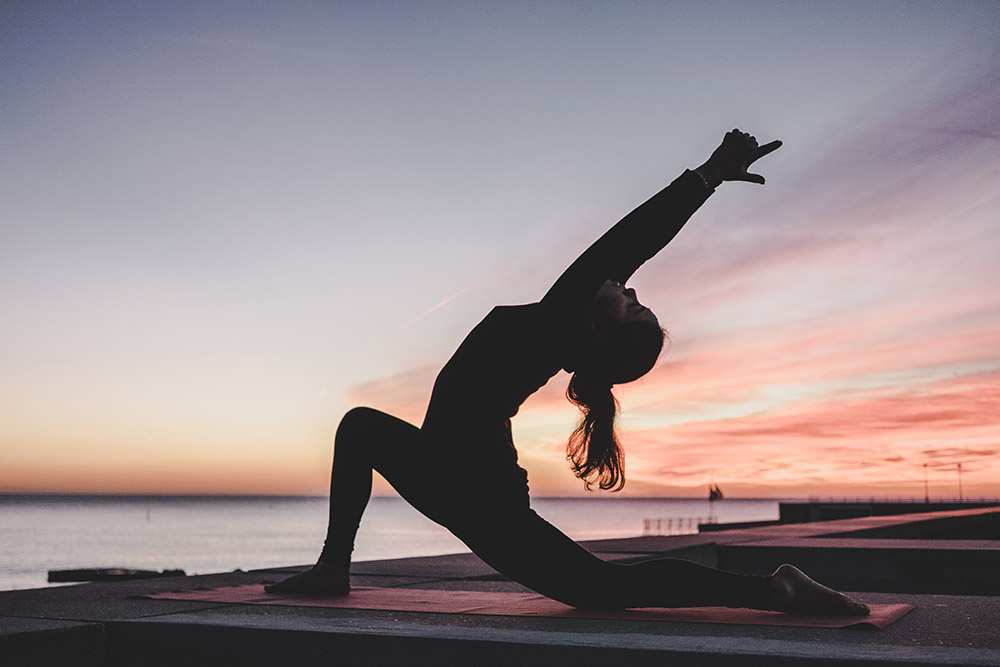Nordic Walking: The Best Exercise To Improve Functional Capacity In The Elderly

Hunter Bennett
I have a personal love for all things strength training. I think it is one of the best ways to improve health, performance, and function, in almost every population on the planet.
But that doesn’t mean I am not interested in other types of training.
In fact, I am always on the look for new exercises that I can recommend to people as a way for them to get the most out of their life on a daily basis.
Which is exactly where Nordic walking comes into the equation.
What is Nordic walking?
Nordic walking is a specific type of exercise that has you walking while simultaneously using two specially designed poles. These poles are driven into the ground every single step, which allows you to stress your upper body as well as your lower body – which is in stark contrast to regular walking.
Try and picture cross country skiing on land, and that is Nordic Walking.
Nordic walking is low impact and actually enhances stability through the use of the poles. As a result, it offers an extremely effective method of exercising elderly and clinical populations in a very low-risk environment.
There is a very good reason as to why it has been making such a large splash in the health industry of late.
Related Article: Exercise in the Elderly: Balance and Running
Nordic walking technique
As I am sure you can imagine, Nordic walking is best implemented properly. This means making sure that you’re doing it with optimal technique:
- Make sure you try and walk as naturally as possible. It is not a different movement completely, but a variation of normal walking.
- Keep your shoulders relaxed and down. This means making sure they are not hitched up around your ears.
- As you walk, lean your upper body forward slightly.
- Your arms and legs should move in an alternate fashion (think right leg forward as your left stick moves forward)
- Make sure you try and take longer strides than normal.
- Each individual step, make sure to roll your foot forward from your heel to ball.
If you tick each of these off effectively, then you can be pretty certain that you are going to be maximizing the benefits of Nordic walking – which leads us to our next point quite nicely.
What are the benefits of Nordic walking?
Nordic walking essentially increases the intensity of normal walking by integrating your arms into the movement. This increases both the cardiovascular demands of the movement as well as the muscular demands of the movement – both of which can have some rather positive health effects!
Is Nordic walking good for balance?
First and foremost, research has shown that Nordic walking offers an extremely effective way to improve balance in elderly populations (Virág, 2015).
In fact, simply performing Nordic walking a couple of times per week for ten weeks has been shown to cause significant improvements in measures of balance. This is obviously important as it has the potential to reduce the risk of falling in a very big way.
These Nordic walking balance benefits are thought to be derived from the fact that it has the capacity to improve neuromuscular coordination between the upper and lower limbs, while also strengthening the muscles of the lower body.
Is Nordic walking good for weight loss?
Given that Nordic walking integrates both the upper and lower body into a single movement, it actually places a pretty significant energy demand on the body, which has the potential to increase weight loss – something that the research has supported time and time again (Figard-Fabre, 2011).
One of the best ways to use Nordic walking for weight loss revolves around implementing three training sessions per week, for a at least 10 weeks. This protocol has been shown to cause significant reductions in fat mass in a number of different settings.
Does Nordic walking improve posture?
The poles used in Nordic walking actually create a more upright walking posture. This is driven by the chest being up nice and tall, and the shoulders being positioned down and back. Additionally, the fact that it allows you to take longer strides also improves the strength of your hip musculature.
Through a combination of each of these factors, Nordic walking has been shown to cause a significant improvement in posture (Dalton, 2016).
This makes it the perfect option for people who have fallen into the rounded shoulder posture that many of us see on a daily basis (thanks Microsoft…).
Does Nordic walking improve functional capacity in the elderly?
This is where I think things get really interesting.
There is a growing body of research clearly demonstrating that in elderly populations, Nordic walking can improve functional capacity in a very big way. This means that it can make it easier for people to manage their daily lives (Bullo, 2018).
Which is pretty damn important for everyone…
Now, these improvements in functional capacity appear to come from increases in aerobic fitness, leg muscle strength, dynamic balance, and upper body flexibility – all of which are essential to your ability to perform tasks of daily living as you get older.
It is arguably one of the most bangs for your buck exercises on the planet for elderly populations!
Is Nordic walking good for mental health?
In conjunction with the obvious physical benefits of Nordic walking, there are also some mental benefits of Nordic walking that deserve discussion (Park, 2015).
Some recent studies have shown that Nordic walking intervention can reduce depression and improve mental health. Additionally, it has also been shown to improve sleep quality – which, as many of you would know, is integral to reducing both stress and anxiety.
So in short – yes, Nordic walking is very good for mental health.
The Best Nordic walking fitness poles
Arguably the biggest barrier to people getting into Nordic walking comes down to the fact that they don’t have the poles available – which is why we have scoured the web for the best Nordic walking poles on the market!
BAFX Nordic Walking Poles
Talk about bang for your buck.
These Nordic walking poles will set you back around 20 bucks, and they are perfect. Not only are they durable and lightweight, but they are also adjustable. This means that they are suitable for short kids and very tall adults!
With over a whopping 4000 reviews on Amazon (of which 70% have been a full five stars), you can be pretty certain that they work, and that they work well.
TheFitLife Nordic Walking Poles
Next up, we have these great Nordic walking poles by The Fit Life.
These great poles can collapse down into a tiny package, which makes them perfect for taking with you traveling (or simply in the car). As an added bonus, they also integrate anti-shock technology into their base, which is perfect for those individuals who have frail hands.
With more than 800 reviews on Amazon, of which more than 70% have rated them five stars, you can be sure of their quality.
TrailBuddy Trekking Poles
Last, but certainly not least, we have this great option by TrailBuddy.
While they are a touch more expensive than the other two options on this list, you get what you pay for. These poles are made from extremely lightweight, yet durable, aluminum. They are also adjustable, come with some extremely high-quality handles, and even include a super convenient carry bag.
Seriously, what more could you want?
Importantly, they have more than 1800 reviews on Amazon, of which 88% is a maximum five stars.
Talk about being well received!
Related Article: 3 Ways Lifelong Exercise Prevents Aging
Best Nordic walking tips
We now have a clear understanding that Nordic walking actually offers a pretty powerful tool to improve health, fitness, function, and quality of life.
But how do we get the most out of it?
- Use your arms: this is an obvious point, but one that still needs stating. Make a conscious effort to drive through your arms and keep your chest up tall every single step. It is this that increases your energy expenditure, enhances coordination, and increases upper body function.
- Don’t shy away from challenging terrain: the sticks used during Nordic walking actually provide additional stability to your entire body, while also enhancing your ability to drive through each step. This means that you can take on steeper terrain without fear, which will improve your strength development significantly.
- Perform it regularly: because Nordic walking is low impact, it actually places very little joint impact on the body. This means that you can do it regularly without fear of overtraining. I often recommend 3-4 times per week for the best results.
If you can stick to these, then you can expect to see some pretty significant increases in health and function!
Take Home Message
Nordic walking is a great new type of exercise that appears perfect for clinical and elderly populations. It is low impact in nature, yet still allows the development of strength, fitness, and functional capacity.
Seriously, what more could you want?
References
Virág, A., et al. “Short-term and long-term effects of Nordic walking training on balance, functional mobility, muscle strength and aerobic endurance among Hungarian community-living older people: a feasibility study.” The Journal of sports medicine and physical fitness 55.11 (2015): 1285-1292.
Figard-Fabre, H., et al. “Efficacy of Nordic walking in obesity management.” International journal of sports medicine 32.06 (2011): 407-414.
Dalton, Christopher, and Julie Nantel. “Nordic walking improves postural alignment and leads to a more normal gait pattern following weeks of training: A pilot study.” Journal of aging and physical activity 24.4 (2016): 575-582.
Bullo, Valentina, et al. “Nordic walking can be incorporated in the exercise prescription to increase aerobic capacity, strength, and quality of life for the elderly: a systematic review and meta-analysis.” Rejuvenation Research 21.2 (2018): 141-161.
Park, Seong Doo, and Seong Hun Yu. “The effects of Nordic and general walking on depression disorder patients’ depression, sleep, and body composition.” Journal of physical therapy science 27.8 (2015): 2481-2485.
You Might Like:
















